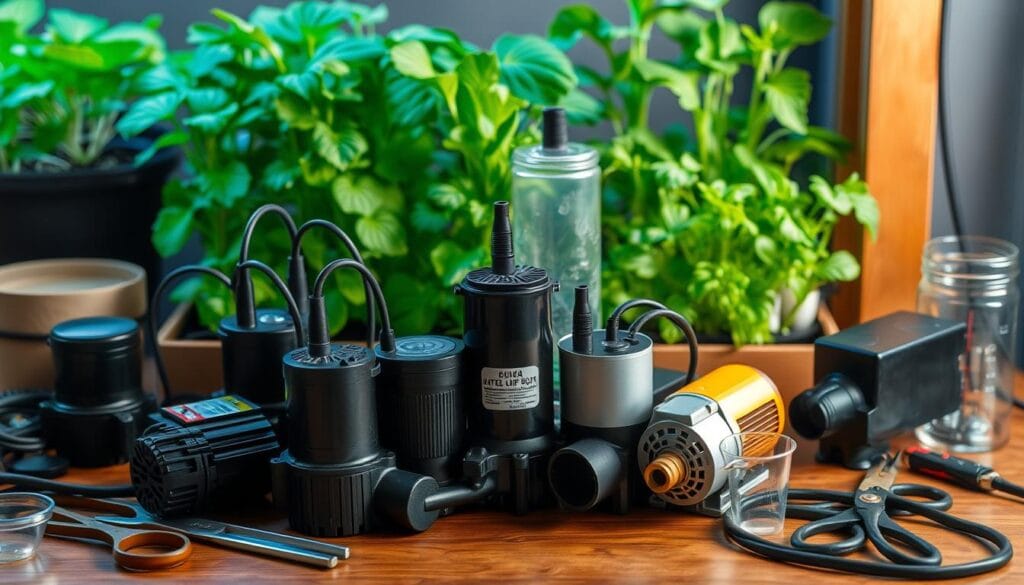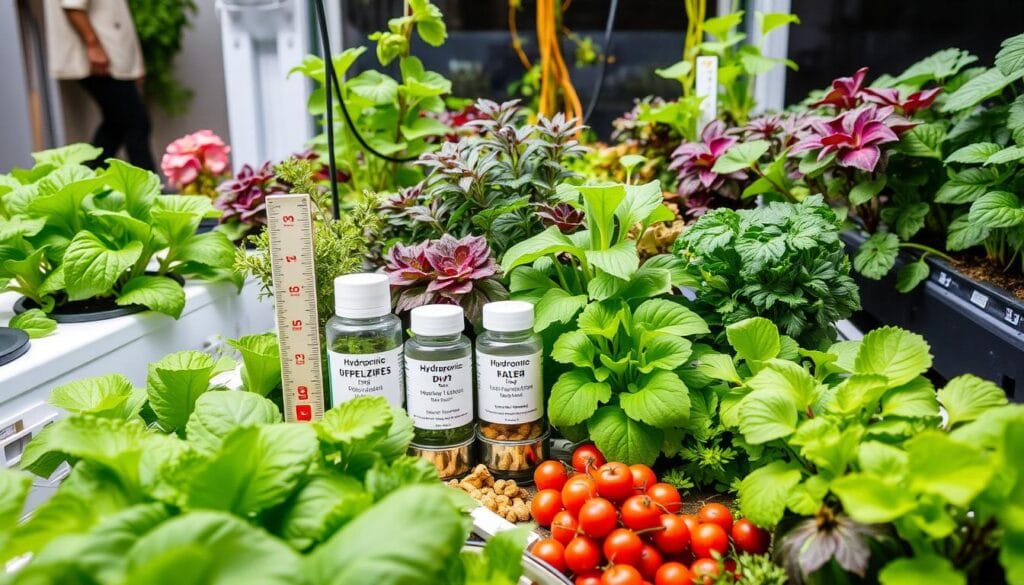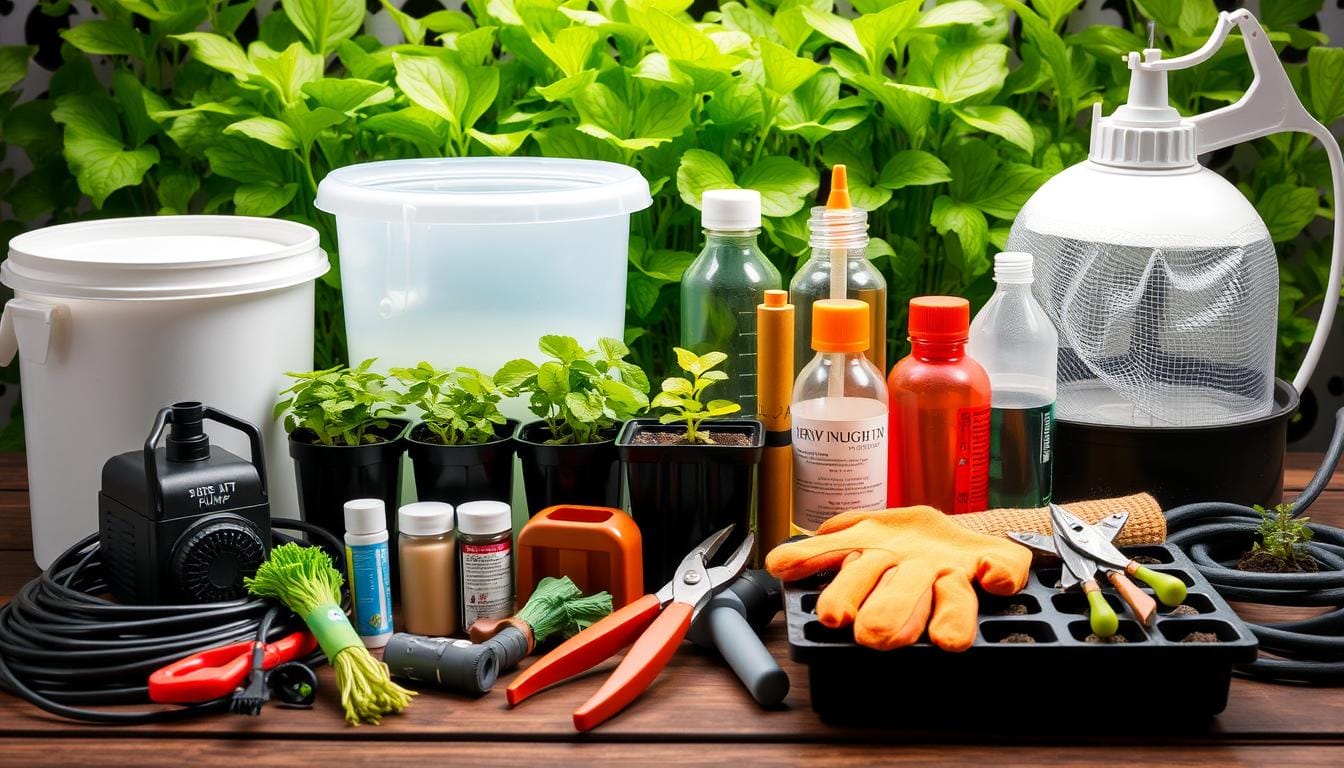Tools for DIY Hydroponics on a Budget can turn your small apartment or backyard into a thriving garden that grows fresh veggies yearly. Hydroponic gardening is not just for pros—it’s for anyone who wants to try it on a budget. Start your hydroponic journey with little money and big dreams.
Budget hydroponics lets you grow healthy food without needing soil. With a few key tools and some creativity, you can create a hydroponic garden. It will save water, cut down on energy, and bring fresh greens to your kitchen.
Whether you’re new to gardening or have lots of experience, DIY hydroponics can change how you grow food. This guide will show you how to start a budget-friendly, efficient hydroponic garden.
Key Takeaways
- DIY hydroponic systems can be created for under $50
- Vertical hydroponic gardening saves up to 30% on labor costs
- Hydroponic techniques require 98% less water compared to conventional farming methods
- Home hydroponic systems can produce fresh produce year-round
- Multiple affordable hydroponic system designs exist for beginners
Understanding Budget-Friendly Hydroponic Systems
Exploring diy hydroponic systems can change your home gardening without spending a lot. Low-cost hydroponic setups have made growing food at home easier and more sustainable.
Hydroponic gardening lets you grow plants with little space and resources. With affordable hydroponic supplies, you can have a thriving indoor garden. It will give you veggies and herbs all year.
Types of Affordable Setups
There are many budget-friendly hydroponic systems for home gardeners:
- Deep Water Culture (DWC) Bucket Systems
- Multi-bucket DWC Configurations
- Nutrient Film Technique (NFT) Setups
- Vertical Grow Systems
Cost Analysis and ROI
Even though starting might cost a bit, hydroponic gardening has big long-term benefits. Your setup will cost between $100-$250. You’ll save money on:
- Water usage
- Higher crop yields
- Less pesticide use
- Year-round growing
Basic System Components
Key parts of StartHome a low-cost hydroponic system are:
- Water Reservoir: 20-30 gallon container
- Growing Tray: Affordable plastic options
- Pumps: For water and air circulation
- Net Pots: Plant support structures
- Growing Medium: Lightweight, drainage-friendly materials
“Hydroponics is more than just gardening—it’s a sustainable revolution you can bring into your own home.”
By choosing the right parts and understanding how they work, you can make a cost-effective hydroponic garden. It will give you fresh, healthy food with little money spent.
Essential Container and Reservoir Solutions
Starting a DIY hydroponic garden? The right containers are key. Affordable options help plants grow well without spending a lot.
Don’t worry about the cost of your DIY hydroponic reservoirs. Plastic storage bins with lids are a great, cheap choice. They cost between $5 to $10 and can turn into good hydroponic systems easily.
- 5-gallon buckets for Deep Water Culture (DWC) systems
- Clear plastic storage containers with tight-fitting lids
- Food-grade plastic bins for nutrient solution reservoirs
- Pond liners for creating larger raft bed systems
The Deep Water Culture system is great with 5-gallon buckets. Pro tip: Net pots, which cost around $5, help keep your plants securely positioned within these containers.
According to Hydroponic Experts, “Choosing the right containers is the cornerstone of effective hydroponic gardening.”
Think about durability, light blockage, and cleaning ease when picking containers. Dark containers stop algae, and clear ones let you see water and roots.
| Container Type | Cost Range | Best For |
|---|---|---|
| Plastic Storage Bins | $5-$10 | Small to Medium Systems |
| 5-Gallon Buckets | $3-$7 | Deep Water Culture |
| Pond Liners | $15-$30 | Large Raft Bed Systems |
Your hydroponic containers are the heart of your system. Spend wisely, and you’ll have a garden that saves water and grows well.
Tools for DIY Hydroponics on a Budget
Setting up a homemade hydroponic system doesn’t have to cost a lot. You can find cheap tools and supplies to make a great system. This way, you can start growing plants without spending too much.
Essential Tool Requirements
Every hydroponic gardener needs basic tools. These tools help you get started without spending a lot. Here’s what you should have:
- pH testing meter ($10-$15)
- Liquid nutrient solutions ($10-$20)
- Air pump with tubing ($15-$25)
- Measuring cups and syringes
- Cleaning supplies
“Efficient hydroponic gardening prioritizes practical solutions over lavish investments.”
Finding Affordable Tools
Looking for cheap tools is easy if you know where to look. Here are some places to find budget-friendly supplies:
- Local hardware stores
- Online marketplaces
- Gardening supply centers
- Second-hand equipment websites
- Community gardening groups
Tool Maintenance Tips
Keeping your tools in good shape is important. Clean them regularly, calibrate them when needed, and store them properly. This will help your tools last longer and work better.
Starting a home hydroponic system can cost as little as $80. It’s a great hobby for those who love gardening but are on a tight budget.
Water and Air Pump Selection Guide
Selecting the right hydroponic pumps is essential for building an effective DIY hydroponic system. Water and air pumps are vital. They make sure your plants get the right food and air.

- Flow rate capacity
- System size compatibility
- Energy efficiency
- Durability
For small to medium hydroponic setups, affordable air pumps are the best. They should move 200-300 gallons per hour. Here are some top pump picks:
| Pump Model | Flow Rate | Power Usage | Price Range |
|---|---|---|---|
| Hydrofarm Active Aqua | 400 GPH | 36W | $30-$40 |
| VicTsing Submersible | 80 GPH | 4W | $20-$25 |
| TetraPond Water Pump | 325 GPH | 25W | $35-$45 |
Pro tip: Always have a backup pump. A pump failure can ruin your crop. So, having a spare is essential.
As Hydroponic Expert says, “In hydroponics, the pump serves as the heart of the system. Make a wise choice, and your plants will thrive.”
When looking at hydroponic pumps, keep these points in mind:
- Reliability of the manufacturer
- Warranty coverage
- Energy consumption
- Compatibility with your specific system
Affordable air pumps cost between $20 and $30. They’re a good choice for DIY hydroponic fans. A good pump is key for nutrient and oxygen flow. This is vital for your plants to grow well.
Growing Media and Support Systems
Choosing the right hydroponic growing media is key to your indoor gardening success. It’s all about finding materials that support your plants well, hold water, and keep roots healthy.
Knowing the different hydroponic growing media can help you create a great plant environment. Each type has its benefits for your system.
Types of Growing Media
- Coco Coir: A sustainable option made from coconut husks that expands when hydrated
- Clay Pebbles (Hydroton): Reusable media that provides excellent drainage and aeration
- Perlite: Lightweight volcanic rock ideal for improving soil structure
- Rockwool: Popular but requires careful handling and disposal
Net Pots for Hydroponics
Net pots for hydroponics are key for plant support and root growth. They let roots grow through and get nutrients while keeping plants stable.
Choosing the appropriate net pot can significantly enhance the performance of your hydroponic system and promote optimal plant growth.
Support Systems for Hydroponics
- PVC pipe structures for vertical growing
- Guttering systems for nutrient film technique (NFT)
- Adjustable hanging supports for different plant sizes
When picking your hydroponic growing media and support systems, think about water retention, reusability, and cost. Your choices will affect plant health and system performance.
Nutrient Management Tools and Solutions

Managing hydroponic nutrients doesn’t have to be expensive. You can make your own nutrient solutions that are both affordable and effective. Investing in good hydroponic fertilizers can greatly improve your indoor gardening.
As Hydroponic Expert puts it, “The key to successful hydroponics lies in understanding your plants’ nutritional requirements and meeting them with precision.”
To make affordable hydroponic nutrients, you’ll need some basic tools and knowledge. Here’s what you’ll need to start:
- pH testing kit
- PPM (Parts Per Million) meter
- Nutrient measuring containers
- Storage bottles for mixed solutions
Making your nutrient solutions can save a lot of money. A 25lb Masterblend nutrient kit usually costs about $60. It can support many growing cycles. The trick is knowing the right nutrient ratios and what your plants need.
Important things to think about for nutrient management include:
- Keeping pH between 5.5 and 6.5
- Testing nutrient concentration often
- Changing solutions based on plant growth stages
Pro tip: Use timers to keep your nutrient solution oxygenated. Also, replace the whole solution every 3-4 weeks for the best plant health.
With good planning and the right tools, you can create a cost-effective nutrient management plan. This plan will help your plants grow well in your hydroponic system.
pH Testing and Control Equipment
Keeping the right pH balance is key for hydroponic gardening success. Your plants’ health and nutrient uptake depends on accurate pH testing. Knowing how to check and adjust pH can be the difference between healthy and struggling plants.
Digital pH meters are the best way to track your hydroponic system’s pH. These meters cost between $20 and $40. They are affordable for both home gardeners and DIY fans.
Essential pH Testing Tools
- Digital pH meters
- pH testing strips
- Calibration solutions
- pH adjustment liquids
Calibration and Accuracy
Regular calibration is vital for accurate pH control in hydroponics. The majority of digital pH meters offer an accuracy of up to 0.01 pH units. But, they need regular upkeep to stay precise.
| pH Testing Method | Accuracy | Cost |
|---|---|---|
| Digital pH Meters | ±0.01 pH | $20-$40 |
| pH Testing Strips | ±0.5-1.0 pH | $5-$15 |
Maintenance Schedule
For the best results, test your hydroponic solution’s pH 2-3 times a week. Most plants do well in a pH between 5.5 and 6.5. This range helps them absorb nutrients best.
“Maintaining a consistent pH balance is essential for cultivating healthy and productive hydroponic plants.”
Items like white vinegar or baking soda can adjust pH when you can’t find commercial solutions. Remember, different plants need slightly different pH levels. So, research what your plants need.
Lighting Options for Indoor Systems
Choosing the right hydroponic grow lights is key to indoor gardening success. Indoor hydroponic lighting is vital for plant growth, as natural sunlight is often scarce. LED grow lights are the top pick for those on a budget, as they are efficient and affordable.
- Light spectrum (380nm-800nm)
- Energy efficiency
- Cost-effectiveness
- Plant-specific light requirements
Here are some top picks for affordable LED lights:
| Grow Light Model | Key Features | Price Range |
|---|---|---|
| Letter Grow Light | 12-hour timer, 10 dimmer settings | $50-$100 |
| Soltech Aspect | 2,000-4,000 lumens, 20-40 watts | $80-$150 |
| LBW Grow Light | Full spectrum, improved plant growth | $60-$120 |
Experts say to keep grow lights on for 12 to 16 hours daily for best plant growth. LED lights use 75% less energy and last much longer than old lighting.
According to Hydroponic Experts, “Choosing the right grow light can elevate your indoor hydroponic garden from mere survival to thriving success.”
Pro tip: Pick lights that fit your plants’ needs. Plants like basil, lettuce, and spinach do well with most standard hydroponic grow lights.
Temperature and Humidity Control Tools
Keeping temperature and humidity right is key for hydroponic gardening success. Your plants’ health relies on the right environment. Affordable temperature regulators can greatly improve your indoor garden.
Effective climate control in hydroponics needs the right tools and methods. Here are the main things to watch and manage in your growing space:
- Digital thermometers for accurate temperature tracking
- Hygrometers to measure humidity levels
- Small fans for air circulation
- Heat mats for root zone temperature management
Managing humidity in hydroponics doesn’t have to cost a lot. Simple methods can keep your plants in the best conditions:
- Place water trays near plants to increase ambient moisture
- Use budget-friendly humidifiers for dry environments
- Employ dehumidifiers in overly humid spaces
- Implement proper ventilation systems
“Consistent environmental control is the secret to thriving hydroponic gardens.” – Hydroponic Experts
When picking temperature and humidity control tools, think about these points:
- Accuracy of measurements
- Cost-effectiveness
- Ease of installation
- Compatibility with your specific hydroponic system
Choosing reliable climate control tools will help you create the perfect environment for your hydroponic plants. You don’t need to spend a fortune.
Monitoring and Maintenance Equipment
Keeping your hydroponic system in top shape needs careful planning and the right tools. Your DIY hydroponics project needs constant care to help plants grow well and the system works efficiently.
It’s important to watch your hydroponic system’s health closely. You need to manage plant growth and stop problems before they start.
Essential Measuring Tools
Getting precise measurements is key to success in hydroponics. Your DIY monitoring tools should include:
- Digital pH meter for accurate nutrient solution testing
- Electrical conductivity (EC) meter to track nutrient concentration
- Thermometer for monitoring water and ambient temperatures
- Digital scale for precise nutrient mixing
Affordable Cleaning Supplies for Hydroponics
Keeping your system clean stops algae and plant diseases. Here are some cheap cleaning items:
- Food-grade hydrogen peroxide
- White vinegar
- Soft brushes for gentle equipment cleaning
- Microfiber cloths
System Maintenance Checklist
| Task | Frequency | Purpose |
|---|---|---|
| pH Level Check | Weekly | Ensure optimal nutrient absorption |
| Nutrient Solution Replacement | Every 2-3 weeks | Maintain nutrient balance |
| Equipment Sanitization | Monthly | Prevent contamination |
As Hydroponic Expert states, “Routine maintenance is essential for ensuring a thriving hydroponic garden.”
Spending time on regular monitoring and upkeep will greatly boost your hydroponic system’s performance and life span.
Conclusion
Starting your journey in budget-friendly hydroponic gardening is a smart move. It’s a way to grow food at home that’s good for the planet. With DIY hydroponics, you can grow fresh, healthy food using less water and resources.
Choosing the right system, like Wick or Deep Water Culture (DWC), is key. These systems help you save up to 90% of water compared to old farming ways. This makes your indoor garden very efficient.
Understanding what your system needs is important. Whether you pick a simple Wick system for herbs or a Drip system for bigger veggies, it’s worth it. You’ll see plants grow faster and get more food from your garden.
LED grow lights and the right nutrients make your garden even better. This way, you can grow food all year round. It marks a substantial move toward environmental sustainability.
Hydroponics offers big advantages over regular gardening. Plants grow 50% faster, and you use less water. It’s also better for the environment.
Pay attention to things like humidity, light, and nutrients. Your DIY hydroponics can change how you grow food at home.
Success in hydroponics comes from learning and trying new things. Begin with small steps and gradually build your expertise. You’re helping create a greener, more efficient future for growing food at home.

